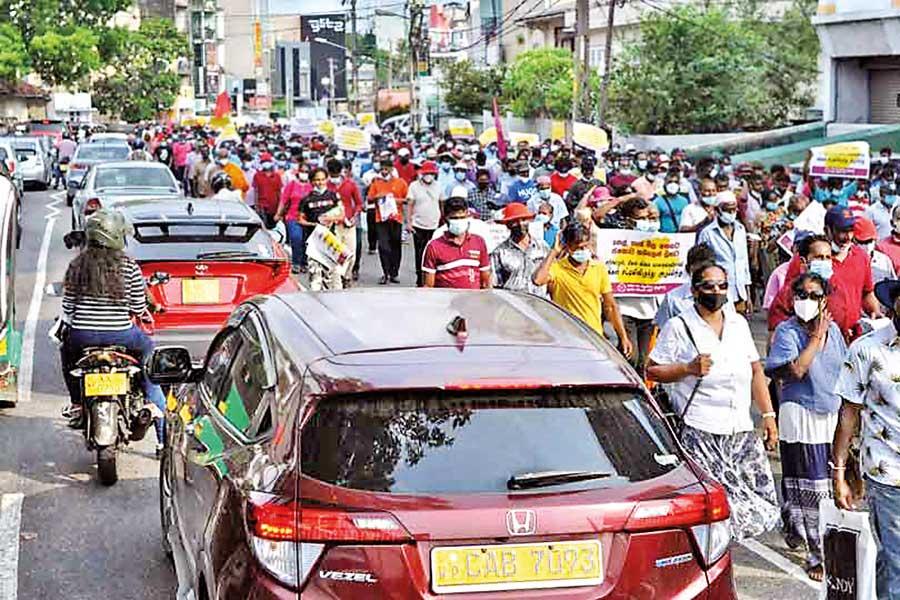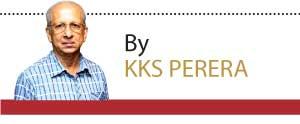08 Jul 2024 - {{hitsCtrl.values.hits}}
Interests of the country should take precedence over party interests

Demonstrations which involves trying to enter a building without permission, trespassing and creating noise nuisances are punishable by law
The 1940s and 1950s are often considered the “Golden Era” of the LSSP (Lanka Sama Samaja Party). During this period, 70-80% of the trade unions in the country adhered to LSSP
 politics, with the most prominent being the Government Clerical Service Union (GCSU), which supported the political struggle of the LSSP. The general strike of 1947 and ‘Hartal’ (strike) in 1953 were followed by a series of strikes from 1956 to 1964 led by Dr. N.M. Perera and his ‘comrades’. Wildcat work stoppages were a common occurrence until the LSSP and CP (Communist Party) joined forces with the SLFP (Sri Lanka Freedom Party) in a coalition in 1964.
politics, with the most prominent being the Government Clerical Service Union (GCSU), which supported the political struggle of the LSSP. The general strike of 1947 and ‘Hartal’ (strike) in 1953 were followed by a series of strikes from 1956 to 1964 led by Dr. N.M. Perera and his ‘comrades’. Wildcat work stoppages were a common occurrence until the LSSP and CP (Communist Party) joined forces with the SLFP (Sri Lanka Freedom Party) in a coalition in 1964.
Dr. Perera, who became the Minister of Finance in Sirimavo’s coalition government, struggled to manage a strike by workers in his own Giridara Mills. Despite having organized numerous strikes that disrupted various governments since the 1930s, Dr. Perera faced a particularly challenging situation during his second tenure as Minister of Finance in Sirimavo’s 1970-75 administration, when bank employees launched a strike on September 1, 1972. The strong Ceylon Bank Employees Union (CBEU) initiated their longest strike in history, lasting 108 days and causing unprecedented damage to the economy. Dr. Perera had to counter the union’s actions with strong measures. Similarly, if the JVP were to come to power now, they too would face the same challenges. They, like their predecessors, would need to navigate these complexities to maintain stability and economic progress.
The general strike of 1947 and ‘Hartal’ (strike) in 1953 were followed by a series of strikes from 1956 to 1964 led by Dr. N.M. Perera and his ‘comrades’
If the cash-strapped government were to grant all the current strikers’ demands, the next government regardless of who wins the election, would face a severe economic disaster within a few months. Moreover, the new administration would find it challenging to manage the workforce, as they would remain in a combative or agitated state.Launching a countrywide strike action on July 10, 2008, was highly contentious, especially considering the island was partially engulfed in a civil war. The local businesses were also grappling with severe challenges due to an unprecedented fuel price hike. In this context, the strike, led by the Janatha Vimukthi Peramuna (JVP), was seen by many as not only unfair and unacceptable, but also as a deliberate move to jeopardize the war effort and undermine any credit the Rajapaksas would gain. The action aimed to halt transport, power, banking, and other essential services, causing significant disruptions. This had a particularly detrimental impact on the productivity of the private sector, exacerbating the difficulties faced by businesses during an already turbulent period.
In 1980, during the administration of President J.R. Jayewardene and Prime Minister Ranasinghe Premadasa, over 41,000 workers lost their jobs within a single day as a result of the government’s response to the general strike.July marked 44 years since the unprecedented general strike of 1980, during which approximately 41,800 public and private sector employees lost their jobs in Sri Lanka. The rising prices compelled the working class to demand a monthly salary increase of Rs. 300 and an allowance of Rs. 5 for every point on the cost-of-living index. The government, using its majority power, suppressed opposition political parties and trade unions.
The Trade Unions National Congress (UNC), with the participation of 1,024 trade Union Representatives, held a meeting in March 1980 and decided on a protest campaign during the lunch hour on June 5, 1980. The government warned that if a general strike were launched, it would consider the strikers as having vacated their posts. Consequently, an island-wide state of emergency was declared. On June 5, 1980, during the lunch hour demonstrations held in preparation for a general strike, two gangs emerged from the direction of the Government Supplies Department and Lake House, launching a violent attack on the protesters with stones, cycle chains, and sticks. The situation escalated dramatically when a hand grenade was thrown, tragically killing D. Somapala, a demonstrator from the Supplies Department.
The strong Ceylon Bank Employees Union (CBEU) initiated their longest strike in history, lasting 108 days and causing unprecedented damage to economy
A group in a jeep began throwing stones at the picketers, the sound of an explosion was heard. The police report notes that one person lost his life in the violence. Government MP Merril Kariyawasam was noted to have been seated on the front seat of the jeep involved in the attack. In September 1989, the JVP/DJV (Deshapremi Janatha Vyaparaya) took retaliatory action against Kariyawasam, the MP for Agalawatte, for his alleged role in causing the death of D. Somapala during the June 5, 1980, general strike.
The government announced that if a general strike was launched, the strikers would lose their jobs. On July 16, 1980, the Cabinet convened and, that same night, declared an island-wide State of Emergency. Despite this, nearly 90,000 workers participated in the general strike of July 1980, effectively crippling the government’s administrative functions and disrupting daily services. On July 24, 1980, Prime Minister, Ranasinghe Premadasa, announced that the 41,000 workers who had failed to report for work had vacated their posts. Following this announcement, several key figures involved in the strike, including trade unionists Vasudeva Nanayakkara, Alavi Maulana, Dr. Vikramabahu Karunaratne, Gunasena Mahanama, and D.I.G. Dharmasekera, were arrested and remanded. The State of Emergency, which had been imposed to suppress the general strike, was lifted in August 1980.
The aftermath of the strike was devastating for many workers. 56 strikers who lost their jobs committed suicide due to their inability to cope with the suffering and hardships faced by their families.In the UK, it is a criminal offence for picketers to block people or vehicles trying to get into the workplace that is on strike, which is referred to as ‘causing an obstruction’ by the police. Carrying weapons, damaging property, or causing or threatening to cause a ‘breach of the peace’ are also illegal activities during picketing. Additionally, picketers are not allowed to try to block roads near the picket line, which is known as ‘causing an obstruction to the public highway,’ or to interfere with the police who are present at the workplace to perform their duties.
Need stringent laws
Legal action can be taken against individuals who break these laws or encourage others to do so while picketing. This includes trespassing, which involves trying to enter a building without permission, and creating a noise nuisance. Using threatening language or offensive material, including libel or slander in leaflets, banners, placards, chants, or speeches, is also punishable by law. If a court order is issued banning picketing or restricting the activities of the trade union, breaking this order could lead to additional legal consequences.
Unlike in many other countries, there are no restrictions in our country on trade unions calling for sudden work stoppages. This unrestricted freedom sometimes leads trade unions to act irresponsibly, to the detriment of the nation. The interests of the country and the public should take precedence over party interests. While trade unions have a reasonable right to strike, except in a few situations, this right should be exercised sensibly and be limited to genuine trade disputes.
24 Nov 2024 3 hours ago
24 Nov 2024 5 hours ago
24 Nov 2024 6 hours ago
24 Nov 2024 7 hours ago